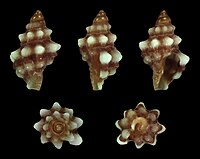Biology:Mancinella armigera
| Mancinella armigera | |
|---|---|

| |
| Museum specimen | |
| Scientific classification | |
| Domain: | Eukaryota |
| Kingdom: | Animalia |
| Phylum: | Mollusca |
| Class: | Gastropoda |
| Subclass: | Caenogastropoda |
| Order: | Neogastropoda |
| Superfamily: | Muricoidea |
| Family: | Muricidae |
| Subfamily: | Rapaninae |
| Genus: | Mancinella |
| Species: | M. armigera
|
| Binomial name | |
| Mancinella armigera Link, 1807
| |
| Synonyms[1] | |
| |
Mancinella armigera is a species of sea snail, a marine gastropod, in the family Muricidae, the murex snails or rock snails.[1][2] The species name means “bearing arms”.[3]
Description
These large drupes have thick , spindle shaped shells covered by blunt tubercles, the aperture is yellowish brown.[3] But they are harmless to humans.[4] The shell is biconic, spire projecting and massive with two rows of projecting noodles on the last whorl, white in color with a yellow aperture.[5] The spire is projecting and acuminate, the suture is shallow.[5] There are eight axial ribs with two rows of prominent tubercles encircling the last whorl and a single spiral of tubercles on the other whorls, as well as a spiral sculpture of fine striae.[5] The aperture is ovate, the outer lips slightly thickened, with six denticles and a columella with a single absolute plait and a moderately developed siphonal fasciole.[5] The shell is often covered with a thick calcareous deposit.[5] The size of an adult shell varies between 50mm and 105.5mm. The shells are typically covered with a pink coralline algae.
Biology
This species is a non broadcast spawner. Life cycle does not include trochophore stage. [4]
Distribution
This species is distributed in the Indian Ocean along Chagos, the Aldabra Atoll and Tanzania; in the Pacific Ocean along Japan .
Habitat
These gastropods occur at the outer edge of fringing reefs and subtitle lava shoulders exposed to heavy wave action.[5] They are common along some exposed rocky coasts at depths of 10-40ft[3] and they often occur in pairs.
Human uses
Collected for food by coastal populations.[4]
References
- ↑ 1.0 1.1 MolluscaBase (2018). Mancinella armigera Link, 1807. Accessed through: World Register of Marine Species at: http://www.marinespecies.org/aphia.php?p=taxdetails&id=396999 on 2019-01-06
- ↑ Claremont M., Vermeij G.J., Williams S.T. & Reid D.G. (2013) Global phylogeny and new classification of the Rapaninae (Gastropoda: Muricidae), dominant molluscan predators on tropical rocky seashores. Molecular Phylogenetics and Evolution 66: 91–102. [Published online 28 September 2012; Code-compliant paper version published January 2013]
- ↑ 3.0 3.1 3.2 Hoover, John P. (2010). Hawai'i's sea creatures : a guide to Hawai'i's marine invertebrates. Mutual Pub. ISBN 978-1-56647-220-3. OCLC 1293454919. http://worldcat.org/oclc/1293454919.
- ↑ 4.0 4.1 4.2 "Thais armigera, Belligerent rock shell". https://www.sealifebase.ca/summary/Thais-armigera.html.
- ↑ 5.0 5.1 5.2 5.3 5.4 5.5 Kay, E. Alison (1979). Hawaiian marine shells. Honolulu, Hawaii: Bishop Museum Press. ISBN 0-910240-26-4. OCLC 5954550. https://www.worldcat.org/oclc/5954550.
- Spry, J.F. (1961). The sea shells of Dar es Salaam: Gastropods. Tanganyika Notes and Records 56
External links
- Link, D.H.F. (1807-1808). Beschreibung der Naturalien-Sammlung der Universität zu Rostock. Adlers Erben
- Reeve, L. A. (1846). Monograph of the genus Purpura. In: Conchologia iconica, or, illustrations of the shells of molluscous animals, Vol. 3. L. Reeve & Co., London. Pls. 1-13 and unpaginated text
- "Reishia armigera" (in en). Gastropods.com. http://www.gastropods.com/3/Shell_1483.shtml.
Wikidata ☰ {{{from}}} entry
 |


